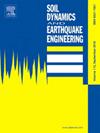Strain accumulation of marine clay under long-term cyclic loading: experimental study and modeling
IF 4.2
2区 工程技术
Q1 ENGINEERING, GEOLOGICAL
引用次数: 0
Abstract
Offshore structures are frequently subjected to hundreds of thousands of cyclic loadings over their service life due to environmental factors such as wind and waves. Despite extensive research, accurately predicting the permanent deformation of marine soils under long-term cyclic loading remains a challenging issue. In this study, a series of undrained cyclic triaxial tests (CTTs) were conducted on marine clays, considering variations in cyclic deviatoric stress, initial static shear stress, and initial mean effective stress. The experimental results indicate that the permanent axial strain increases with cyclic stress ratio (CSR), initial static shear stress, and initial mean effective stress. Furthermore, the shear strain amplitude is found to be positively correlated with the rate of permanent strain accumulation. Based on these findings, an empirical model is proposed to estimate the permanent strain of clay, incorporating the effects of shear strain amplitude and other key influencing factors. The model is further refined through the incorporation of a reference shear strain parameter, which accounts for the influence of plasticity index. Finally, the modified model was validated using datasets from previous studies. A comparison between the predicted and measured results demonstrates the model's effectiveness in capturing the permanent strain behavior of clays subjected to cyclic loading.
长期循环荷载作用下海相粘土的应变累积:试验研究与模拟
由于风、浪等环境因素的影响,海上结构在其使用寿命期间经常遭受数十万次的循环载荷。尽管研究广泛,但准确预测长期循环荷载作用下海洋土壤的永久变形仍然是一个具有挑战性的问题。在本研究中,考虑了循环偏应力、初始静态剪应力和初始平均有效应力的变化,对海相粘土进行了一系列不排水循环三轴试验(CTTs)。实验结果表明:轴向永久应变随循环应力比(CSR)、初始静态剪应力和初始平均有效应力的增大而增大;此外,剪切应变幅值与永久应变积累速率呈正相关。在此基础上,提出了考虑剪切应变幅值和其他关键影响因素影响的粘土永久应变估算经验模型。通过加入考虑塑性指标影响的参考剪切应变参数,进一步完善了模型。最后,利用前人研究的数据集对改进后的模型进行验证。预测结果与实测结果的对比表明,该模型能够有效地反映粘土在循环荷载作用下的永久应变特性。
本文章由计算机程序翻译,如有差异,请以英文原文为准。
求助全文
约1分钟内获得全文
求助全文
来源期刊

Soil Dynamics and Earthquake Engineering
工程技术-地球科学综合
CiteScore
7.50
自引率
15.00%
发文量
446
审稿时长
8 months
期刊介绍:
The journal aims to encourage and enhance the role of mechanics and other disciplines as they relate to earthquake engineering by providing opportunities for the publication of the work of applied mathematicians, engineers and other applied scientists involved in solving problems closely related to the field of earthquake engineering and geotechnical earthquake engineering.
Emphasis is placed on new concepts and techniques, but case histories will also be published if they enhance the presentation and understanding of new technical concepts.
 求助内容:
求助内容: 应助结果提醒方式:
应助结果提醒方式:


